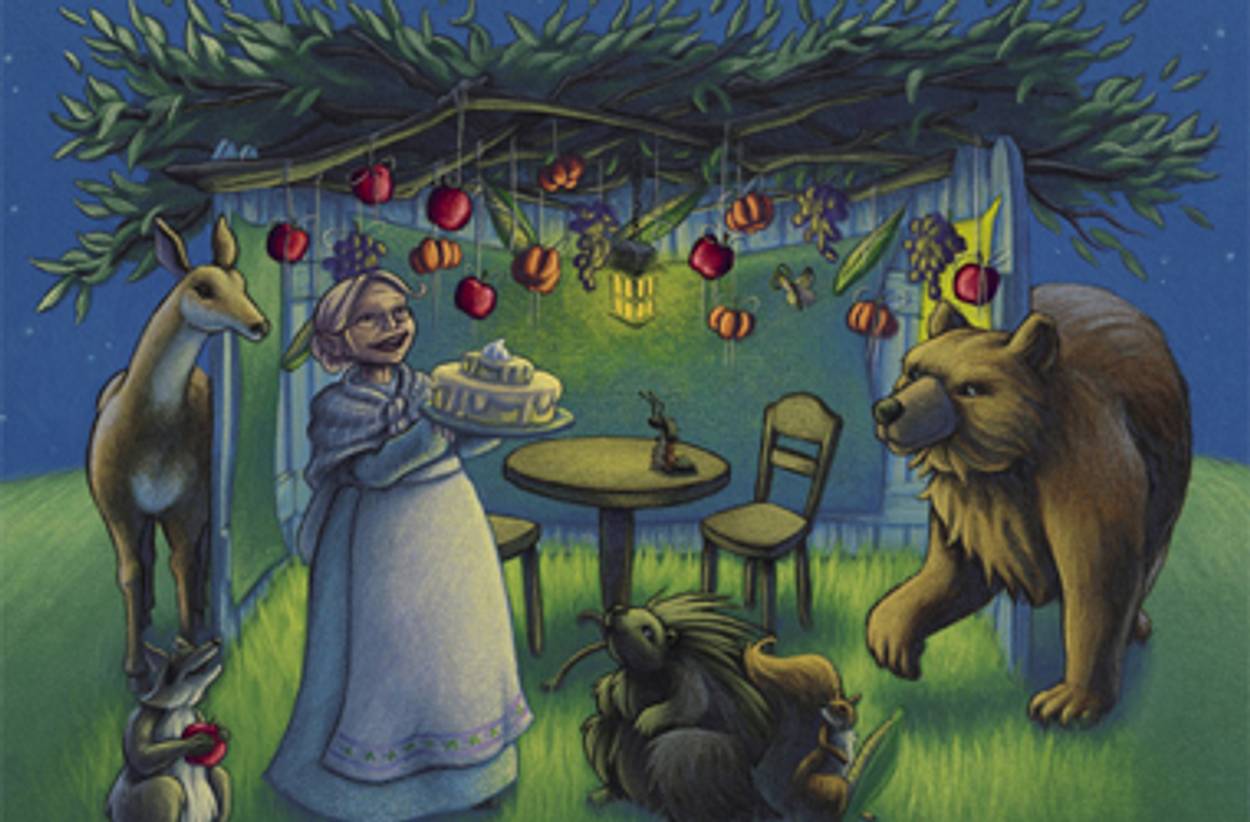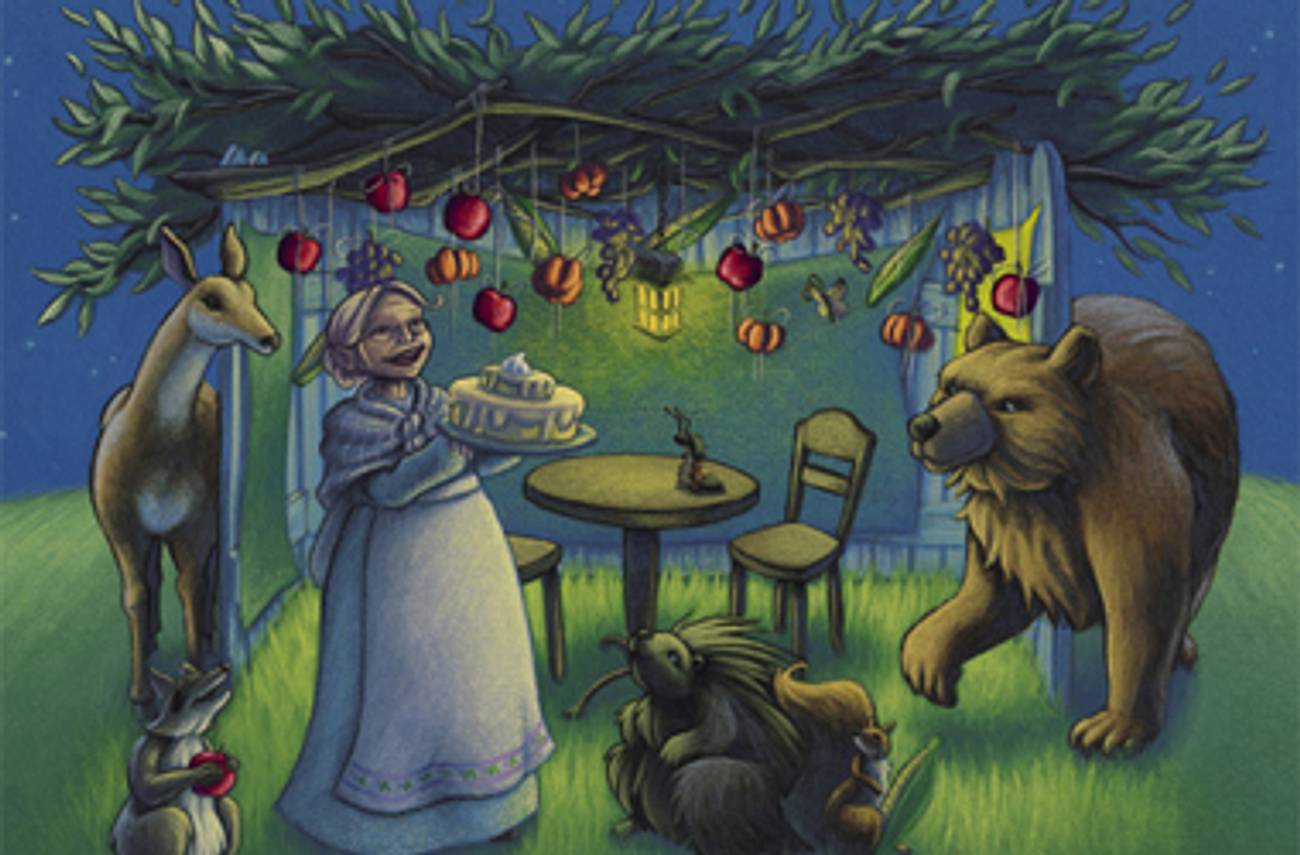Bubbe Needs a Makeover
The problem with portrayals of grandmothers in Jewish children’s books




Here’s an observation: most bubbes in children’s picture books seem to populate a folkloric or historic landscape—a misty, mythical Chagall-esque Old World, or the Lower East Side at the turn of the century, or Holocaust-era Europe. These women have faces etched with deep lines, wispy buns on their heads. They wear babushkas or long, faded, flowery dresses.
Bubbes in these books—titles like Bubbie and Zadie Come to My House by Daniel Halevi Bloom, illustrated by Alex Meilichson; Nine Spoons by Marci Stillerman, illustrated by Perren Gerber; My Grandmother’s Stories by Adele Geras, illustrated by Anita Lobel; and When Mindy Saved Hanukkah by Eric Kimmel, illustrated by Barbara McClintock—are worlds away, literally and figuratively, from the condo in Rhode Island where my kids spend a week with their Bubbe every summer.
A second observation: my mother is hip. She has a chic salt-and-pepper crop and wears chunky jewelry. She’s a tenured professor, working full-time. She’s no princess, but she wears nail polish and doesn’t dress as if she’s 107 years old and living in Chelm.
Why have my children never seen a bubbe like her in their picture books?
What they do see: bubbes perpetually stuck in the kitchen. In Matzah Ball Soup by Joan Rothenberg; Bubbe Isabella and the Sukkot Cake by Kelly Terwilliger, illustrated by Phyllis Horning; Matzo Ball Moon by Leslea Newman, illustrated by Elaine Greenstein; and Rebecca’s Passover by Adele Geras, illustrated by Sheila Moxley, it’s all dowdy grandmothers hoisting ladles and slinging spatulas.
All these grandmothers—historical, folkloric, and contemporary—embody a past as cloying as honeycake. Do their portrayals say something about where we are as Jews in America? Perhaps so many bubbe books are set in the past because our sense of identity today derives from nostalgia for a mythical Fiddler-like existence, or from Holocaust anxiety that’s become a central tenet of Jewish selfhood. (Even in young-adult fiction, geared toward more mature kids, “not only do the bubbes tend to be stereotypical, they also tend to be Holocaust survivors, and they die,” noted Eileen Polk, the librarian at Prentis Memorial Library at Temple Beth El in Bloomfield Hills, Mich.) Maybe the grandmothers in kids’ books look so old—often more like great-grandmothers than grandmothers—because they’re symbols.
“I am sure this phenomenon is related to the larger tendency in American Jewish culture to romanticize the American Jewish past,” explained Jonathan Krasner, assistant professor of the American Jewish experience at Hebrew Union College. “I also imagine that most children’s writers look to their own romanticized pasts for inspiration, rather than the contemporary scene. And rather than conjure up images of plastic covered furniture, dilapidated apartment houses in ethnically changing neighborhoods and inane family feuds—or whatever facts represented the reality of their childhood interactions with their grandparents—what they care to remember is the challah, the carp in the bathtub, the kneidelach.”
I wonder if some younger authors portray bubbes as looking more decrepit than they should because they’re yearning for an older model of grandparent. Their own parents, like my mother and perhaps yours, may be too busy — working, going to city council meetings, living their own lives — to provide spur-of-the-moment babysitting. Is it any wonder that younger picture-book creators, consciously or not, tend to idealize their own grandparents? Craving an old-school model of selflessness and nurturing, they find themselves drawing passels of bubbes who are supposedly grandmothers to two-to-seven-year-olds…but unaccountably look 90.
And then there’s the feminist problem. How do we culturally code the idea of the “Jewish grandmother”? “How do you identify a character as a female Jew? If you draw someone who looks like me, how do we know it’s a bubbe?” Shuly Schwartz, professor of American Jewish history at the Jewish Theological Seminary, asked rhetorically. “How do you know a Jewish woman is doing Jewish things? If she’s making Jewish food!”
Authors and illustrators aren’t sure how to paint modern American Jewish life for children because we aren’t sure how to depict it to ourselves. Our identities as Jews and Americans are integrated. If a bubbe works full-time (she probably can’t afford to retire now anyway), buys frozen latkes, watches HBO, goes to the gym and belongs to a book club, how can a children’s picture book portray her? She’s too complex.
Picture books have to be reductive, since they’re aimed at four-year-olds. But is it necessary to revert to stereotypes that telegraph “old Jew lady”?
Some of the books I’ve named here are terrific. But they require counterpoints that show other faces of bubbetude. Children’s librarians point out that in young adult and middle-grade fiction, there are more nuanced portrayals of Jewish grandmothers. Publishers are trying to bring that sophistication to picture books, too. “We’re always specifically looking for stories that reflect more diverse portrayals of Jewish families,” says Joni Sussman of Kar-Ben books. “We’ve put the word out, but that means now we’re getting too many stories about ‘Bubbe is hip! She rides a bicycle!’”
Kar-Ben has a current title called A Grandma Like Yours/A Grandpa Like Yours, by Andria Warmflash Rosenbaum, illustrated by Barb Bjornson, in which grandparents are portrayed as cute animals. As now-grown fans of Bread and Jam for Francis or Sylvester and the Magic Pebble may recall, it’s an effective device in kids’ lit which allows children to project themselves and their families onto the characters no matter what their families look like. The notion of embracing difference is commendable. If only it would extend to grandmothers of the homo sapien kind.
Marjorie Ingall is a columnist on parenting for Tablet Magazine.
Marjorie Ingall is a columnist for Tablet Magazine, and author of Mamaleh Knows Best: What Jewish Mothers Do to Raise Successful, Creative, Empathetic, Independent Children.
Marjorie Ingall is a former columnist for Tablet, the author of Mamaleh Knows Best, and a frequent contributor to the New York Times Book Review.